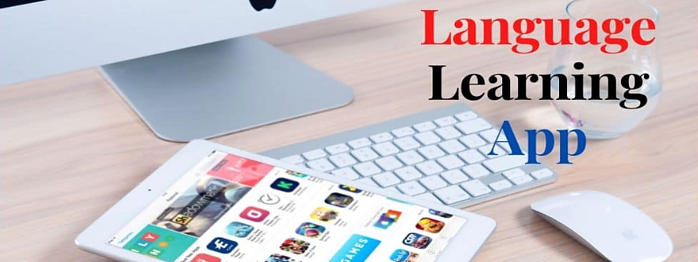Learning Languages With an AI App
Learning a new language is easy for some and downright difficult for others. As an ESL teacher, I strongly recommend a classroom approach to learning a language. But that does not mean I do not agree with other styles of learning. One of the best I use for myself is having an app on your phone you can use anywhere.
So let’s dive in and see if you agree with some of my statements.
The Symbiosis of Classroom and App-Assisted Language Learning
- Benefits of Traditional Classroom Learning for Language Acquisition: Traditional classroom learning provides a structured environment for language learning. It offers direct interaction with a teacher and peers, which can enhance understanding and fluency. Classroom learning also provides immediate feedback, which is crucial for language acquisition. And possibly even more important, it provides students with seeing how words are formed visually, and rather than having to hunt for answers if using an app, you can ask the teacher to explain.
- Identifying Gaps in Classroom Learning and Leveraging Apps for Reinforcement: While classroom learning is beneficial, it may not cater to individual learning styles and pace. Language learning apps can fill these gaps. They allow learners to practice at their own pace and according to their own schedule. Apps can reinforce what is taught in the classroom and provide additional practice in areas where a learner may be struggling.
- How Apps Offer Personalized Repetition and Aid Retention: Repetition is key in language learning, and apps excel at this. They can offer personalized repetition exercises based on a learner’s performance. This targeted practice aids retention and helps learners master the language more effectively.
- The Importance of Immediate Corrections and Native Pronunciation Examples in Class Versus Apps: Immediate correction in a classroom setting helps learners rectify mistakes in real time. However, native pronunciation examples may be limited in a classroom. Apps can provide a wide range of native pronunciation examples, helping learners understand the nuances of the language. Some apps even offer speech recognition technology for immediate pronunciation correction, making them a great supplement to classroom learning.
The Role of AI in Language Learning
- Introduction to AI-Driven Language Learning Apps: AI-driven language learning apps are like smart tutors in your pocket. They use Artificial Intelligence to make learning a new language easier and more efficient. These apps can adapt to your learning style, provide instant feedback, and even understand and correct your pronunciation.
- How AI in Apps Adapts to Individual Learning Styles and Paces: Every person learns differently and at their own pace. AI in language learning apps can understand this. It observes how you learn and then adjusts the lessons to fit your style and speed. This means you get a personalized learning experience, which can help you learn a new language faster.
- Examples of Speech Recognition and Machine Learning in Language Reinforcement: Many language learning apps use speech recognition. This means the app can listen to you speak and correct your pronunciation. Machine learning is another technology used in these apps. It allows the app to learn from your mistakes and your progress, and then adjust future lessons accordingly. This constant reinforcement helps you to better remember and use the new language.
- Contrasting AI’s Immediate Translations with In-Person Teacher Guidance: AI can provide immediate translations, which is very helpful. But it’s different from having a teacher. A teacher can explain things in different ways and answer your questions. They can also understand your feelings, like if you’re finding a lesson hard. AI is getting better, but it’s not the same as a human teacher. Yet, the two can work together to provide a powerful language-learning experience.
Remember, the goal is to show how AI-driven apps and traditional classroom learning can complement each other in language learning. !
Finding Your Learning Style:
- Different Learning Styles and Their Impact on Language Study: People learn in different ways. Some people learn by listening, some by seeing, and others by doing. These are called auditory, visual, and kinesthetic learning styles. The way you learn can impact how quickly and effectively you pick up a new language.
- How to Identify Your Personal Learning Preferences: It’s important to know your learning style. You can do this by thinking about how you learn best. Do you remember things better when you hear them, see them, or do them? Once you know your style, you can use it to help you learn a new language.
- Strategies to Combine Classroom Lessons with App Learning for Various Learning Styles: Classroom lessons and language apps can work together. If you’re a visual learner, you might use an app that has lots of pictures. If you’re an auditory learner, you might use an app that lets you listen to native speakers. And if you’re a kinesthetic learner, you might use an app that has interactive exercises.
- The Role of Auditory, Visual, and Kinesthetic Elements in Language Apps: Language apps use sound, images, and interaction to help you learn. These match up with the auditory, visual, and kinesthetic learning styles. So no matter what your learning style is, there’s an app that can help you learn a new language.
Remember, the goal is to show how understanding your learning style and using the right strategies can make learning a new language easier and more effective.
My Top Language Learning Apps.
Mondly
Mondly is a language-learning app that uses gamification to make learning a new language fun and engaging. It offers short and engaging lessons that focus on useful vocabulary. However, it doesn’t place as much emphasis on grammar or speaking skills as other apps. Let’s look a bit closer. (Click the above link to find the latest deals)
Upon logging in, the first screen you see is the Mondly dashboard, which has a map-like appearance. There are several landmark icons on this map, and each one stands for a distinct subject or idea.
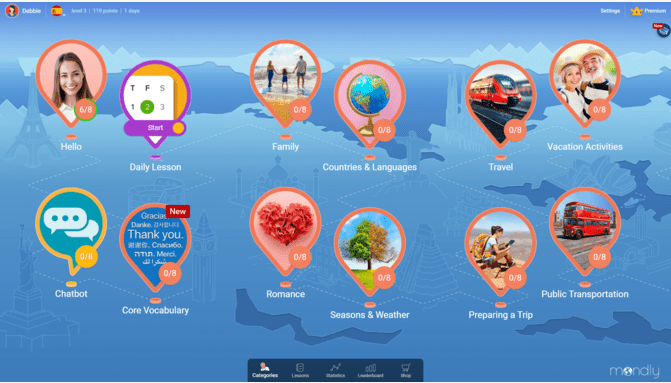 You can view each of these various “landmarks” by swiping left to right across the interactive map. Among many other things, these subjects include the weather, travel, and family. Once you click on a topic, there are typically six to eight lessons within it.
You can view each of these various “landmarks” by swiping left to right across the interactive map. Among many other things, these subjects include the weather, travel, and family. Once you click on a topic, there are typically six to eight lessons within it.
Mondly offers daily lessons that you can either finish directly by diving into one of these “stand-alone” topics. Because the topic lessons tend to build upon one another, the daily lessons are really just Mondly’s suggested order of operation.
The curriculum’s core lessons are these daily ones, though you can always go ahead and skip lessons if you’d like. You can also access a weekly quiz if you finish all of your daily lessons for the week. In addition, you can access a monthly challenge after finishing all of your weekly quizzes.
Hopefully, you can see where this is going. Consistency and streaks are important to Mondly, and you typically adhere to this by taking the assigned daily lessons.
The Lessons
Each lesson consists of about twelve short, interactive drills and exercises covering the four main communication domains: speaking, reading, writing, and listening.
Among these drills are:1. Spelling words and phrases; 2. Listening to words and phrases in your target language and then repeating them; matching phrases to images (which is very similar to Rosetta Stone); 3. Completing mock conversations by choosing the appropriate response; translating sentences between languages; and listening to a question and choosing the appropriate multiple-choice answer.
Mondly makes an effort to gamify and enjoy the process of learning a language. It’s pretty cool that the main dashboard has the appearance of an interactive map, and you can always view your stats from the navigation bar.
Virtual Reality
Mondly provides virtual reality (VR) and augmented reality (AR) learning apps in addition to their standard app and language courses. These apps are intended to supplement the standard lessons.
This is the main way that Mondly sets itself apart from rivals. Mondly is kind of a pioneer in the field of digital language learning because of the novelty of the programs.
You can immerse yourself in virtual environments with the Mondly VR app. You’re thrown into a variety of scenarios where you have to communicate with locals, such as making travel arrangements, ordering takeout, or going grocery shopping. Put another way, the app aims to use virtual reality to mimic authentic scenarios with native speakers.
In case you lack a VR headset, Mondly provides their augmented reality app at no cost when you register for a premium account. Using augmented reality technology, the AR app scans your room and creates animations and a computer-generated teacher for you to enjoy in your own home.
Please go to Mondly to view their pricing. They do have a free version, however, that is very limited. Most people go for the premium price structure which is only $10 per month or $48.00 if paying yearly in advance. Mondly is very cheap when compared with other language apps.
My Opinion
There are a lot of good points about Mondly. Gamification and low cost are the obvious ones. But it does let itself down in the grammar department and it isn’t the best in developing your conversational skills. But you can’t beat the price.
Babbel

Babbel is an online, self-paced language-learning program that offers high-quality lessons unique to each language. It’s more challenging than most other language apps, but the exercises can be tedious. Babbel is best for people already skilled at learning languages or those who already speak a language related to the one they want to learn
Babbel is a language learning app that offers courses in 14 different languages. It uses a variety of methods to teach languages, including interactive lessons, games, and real-life conversations with native speakers. Babbel is designed to be user-friendly and accessible, and it can be used on a variety of devices, including smartphones, tablets, and computers.
The app is based on the spaced repetition system, which means that it repeats words and phrases at increasing intervals to help you remember them. Babbel also uses a variety of other techniques to help you learn, such as interactive exercises, quizzes, and games.
One of the things that sets Babbel apart from other language-learning apps is its focus on real-life conversations. The app features dialogues that are recorded by native speakers, and you can practice speaking and listening by recording your own responses. Babbel also offers live tutoring sessions with native speakers, which can be a great way to get personalized feedback on your progress.
Babbel is a subscription-based service, and the cost varies depending on the length of your subscription. The app is available in both a free and a paid version. The free version gives you access to a limited number of lessons, while the paid version gives you access to all of the app’s features.
Overall, Babbel is a well-designed and effective language-learning app that is suitable for a variety of learners. It is easy to use and accessible, and it offers a variety of methods to help you learn.
 In my opinion, though it will not make you a fluent speaker of the language you have chosen.
In my opinion, though it will not make you a fluent speaker of the language you have chosen.
Rosetta Stone.
The cleverly named language app “Rosetta Stone” was a key to deciphering Egyptian hieroglyphs, which allowed scholars to read and understand ancient Egyptian texts and inscriptions.

But our Rosetta Stone is a comprehensive language-learning software that helps you build a solid foundation in a foreign language. It’s excellent for beginners and offers a ton of additional content for more advanced learners. However, it won’t make you 100% fluent.
Rosetta Stone is a language learning app that offers courses in 25 different languages. It uses a variety of methods to teach languages, including interactive lessons, games, and real-life conversations with native speakers. Rosetta Stone is designed to be user-friendly and accessible, and it can be used on a variety of devices, including smartphones, tablets, and computers.
The app is based on the immersion method, which means that it teaches you a foreign language through context versus through translations. Rosetta Stone courses used to be entirely software-based (meaning you had to purchase a physical CD or download the program to your computer). However, courses are now offered through online subscription so users don’t need to buy the course outright.
One of the things that sets Rosetta Stone apart from other language-learning apps is its focus on pronunciation. The app features speech recognition technology that helps you practice your pronunciation by comparing your voice to that of a native speaker. Rosetta Stone also offers live tutoring sessions with native speakers, which can be a great way to get personalized feedback on your progress.
Rosetta Stone is a subscription-based service, and the cost varies depending on the length of your subscription. The app is available in both a free and a paid version. The free version gives you access to a limited number of lessons, while the paid version gives you access to all of the app’s features.
Overall, Rosetta Stone is a well-designed and effective language-learning app that is suitable for a variety of learners. It is easy to use and accessible, and it offers a variety of methods to help you learn. However, some users may find the immersion method challenging, and the app may not be suitable for those who prefer a more structured approach to language learning.
TalkPal.
Talkpal is a brand new app. that has just come onto the market and offers 57 languages that they say offer a new way to learn.
What distinguishes TalkPal from other applications for language learning?
TalkPal employs cutting-edge AI to offer an interactive, enjoyable, and captivating language learning experience, in contrast to existing language learning applications. With the use of artificial intelligence and an active learning strategy, users can become fluent. TalkPal replicates authentic situations in which users engage with native speakers to acquire knowledge.
TalkPal provides two membership options: TalkPal Premium, which has more advanced capabilities and no restrictions, and a free subscription with restricted features. TalkPal Premium offers the choice of monthly or yearly payments. These begin at $10 a month, or $5 if paid annually.
TalkPal provides comprehensive coverage of grammar, allowing you to understand the subtleties and complexities of other languages and, as a result, improve your speaking, reading, writing, and comprehension abilities.
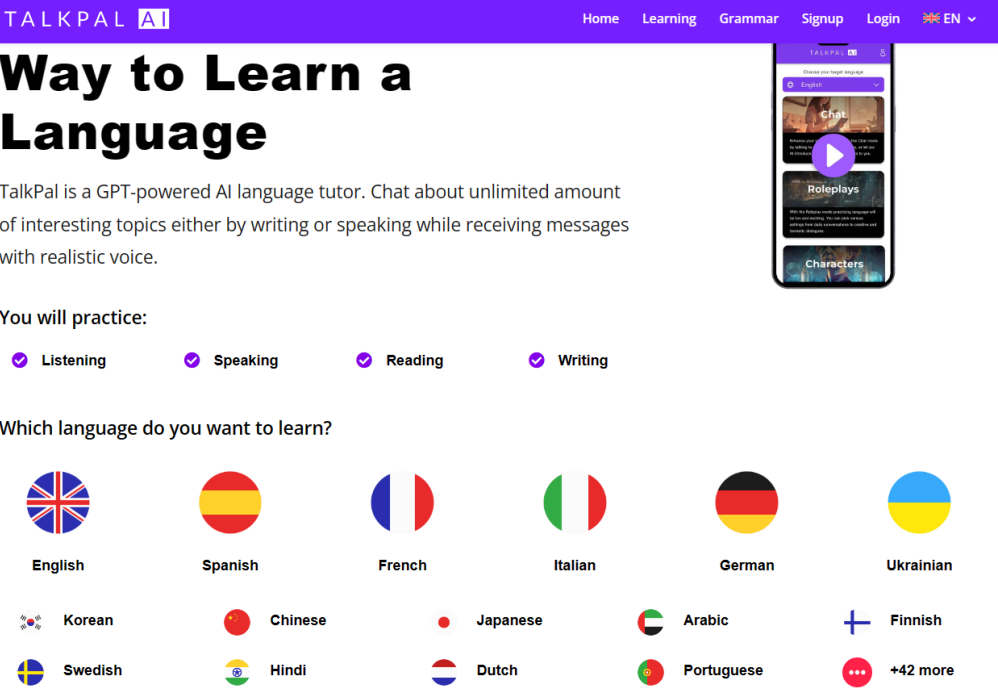
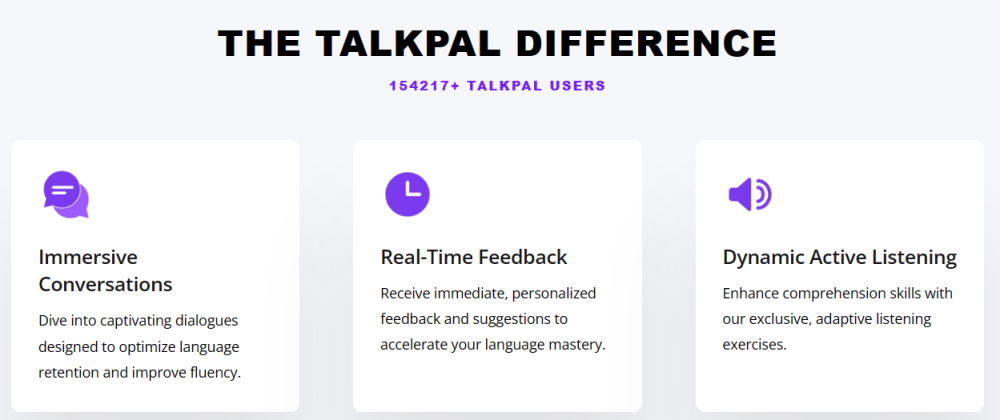 The four basic skills of listening, speaking, reading, and writing are covered and while it is still a new app all the feedback has so far been very positive.
The four basic skills of listening, speaking, reading, and writing are covered and while it is still a new app all the feedback has so far been very positive.
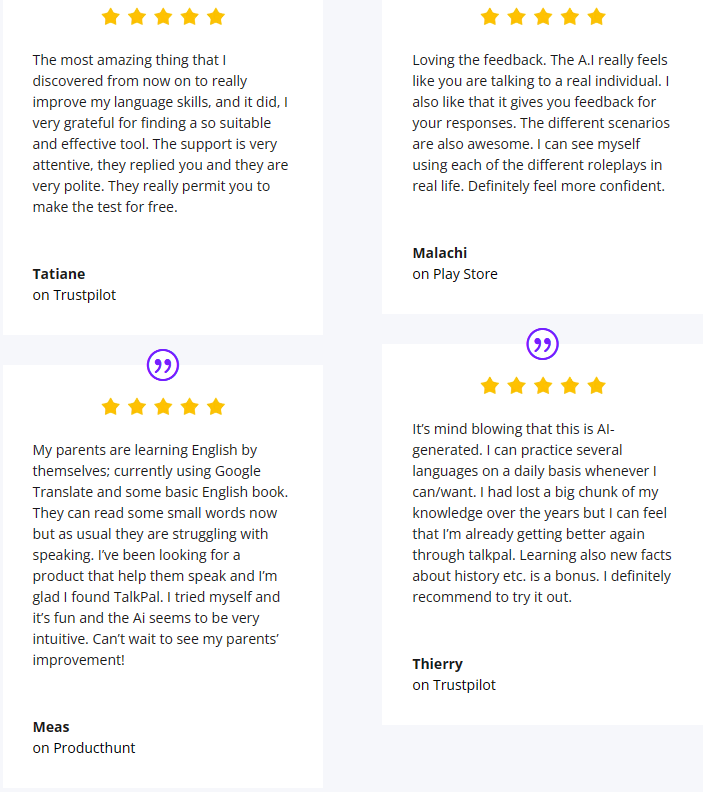
My Opinion.
From an ESL teacher’s perspective, each of these apps has its own strengths and weaknesses.
For example, Mondly’s focus on vocabulary can be useful for beginners, but its lack of emphasis on grammar and speaking skills might be a drawback.
Babbel’s challenging content can be beneficial for advanced learners, but its exercises might be tedious for some.
Rosetta Stone’s comprehensive approach is great for building a solid foundation, but it might not be enough to achieve fluency
Testimonials.
As for testimonials and success stories, many users have found these apps helpful in their language-learning journey.
For example, some users have found Mondly’s gamified learning experience enjoyable and effective. Babbel users have appreciated its challenging content and unique lessons for each language. Rosetta Stone users have praised its comprehensive approach to language learning. Duolingo users have enjoyed its fun and engaging learning experience.
In terms of a comparative analysis of app features, each app offers unique features that align with different learning objectives. For instance, Mondly’s VR & AR apps are game changers in language learning.
Babbel offers live classes and focuses on vocabulary that’s actually useful.
Rosetta Stone offers optional online tutoring sessions. So whichever app suits your style of learning and budget, I wish you the best in your language-learning journey,
The Best App for You!
Choosing the Ideal App: A Comparative Guide for Aspiring Polyglots
- Criteria for Selecting the Best Language Learning App for You: The best app for you depends on your needs and goals. Consider factors like the languages offered, the teaching method, the type of content, and the cost. Also, think about your learning style and how much time you can commit to learning each day.
- A Closer Look at User Interface, Content Quality, and Language Options: A good app should be easy to use, with a clear and intuitive interface. The content should be high-quality, engaging, and updated regularly. And of course, the app should offer the language you want to learn!
- Analyzing Pricing, Subscription Models, and Accessibility of Each App: Some apps are free, while others require a subscription. Consider what you get for the price – does the app offer enough value to justify the cost? Also, check if the app is accessible on your device and if you can use it offline.
- Closing Thoughts on Commitment Beyond Apps for Achieving Language Proficiency: While apps can be a great tool for language learning, they’re just one part of the puzzle. Achieving proficiency requires commitment and practice beyond the app. This includes speaking the language with others, immersing yourself in the culture, and continually challenging yourself.
The goal is how to choose the right language-learning app and how to use it effectively.
If you choose your app on price alone, Mondly stands out against the others. There are a lot of other language apps and each of them has its good and bad points. So take your time and choose one that you feel most comfortable with.
Steve
Any or all links on this site may be affiliate links, and if you purchase something through those links I will make a small commission on them.
There will be no extra cost to you and at times due to my affiliation, you could actually save money.
You can read our full affiliate disclosure here.

